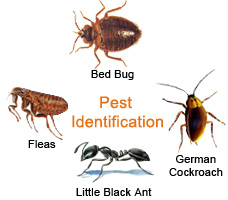NYC Bed Bugs Control & Extermination New York
 Bed bugs are nocturnal, blood-sucking parasites that can be especially difficult to exterminate because they are tiny, flat insects that retreat into hard-to-reach hiding places. They are referred to as bed bugs because they are usually found in the mattresses, box springs, and corners of beds. However, they can also often be found in the cracks and crevices of any type of wooden furniture, as well as on paper surfaces.
Bed bugs are nocturnal, blood-sucking parasites that can be especially difficult to exterminate because they are tiny, flat insects that retreat into hard-to-reach hiding places. They are referred to as bed bugs because they are usually found in the mattresses, box springs, and corners of beds. However, they can also often be found in the cracks and crevices of any type of wooden furniture, as well as on paper surfaces.
The adult bed bug is oval, flat, rusty-red or mahogany in color, and measures 3/16 of an inch long. The bed bug is flat and thin when unfed, but becomes more elongated, plump, and red when it is engorged with blood. Four-segmented antennae are attached to the head between prominent compound eyes. The three-segmented beak, or proboscis, is located beneath the head, and passes back and forth between the front legs. The bed bug cannot fly as its wings are reduced to short wing pads.
Bed bugs generally leave their areas at night to feed on their hosts, and although they prefer to target humans, they often seek out pets as well. The duration of their “meal” can last anywhere between 3-10 minutes. While one may not feel any sensation while the bed bug is actually feeding, the subsequent bite may cause a skin rash, a severe itching reaction, and/or allergies.

Bed Bugs – Nocturnal Blood-sucking Pests
 Bed bugs are blood-sucking parasites that are nocturnal pests. They hide during the day and come out at night. What makes the extermination of these pests very difficult is the fact that they are very small, flat insects and secondly, they are very difficult to trace due to their hiding places, which are not easily reachable. Termed as bedbugs, since they are mostly found hiding on the corners of bed, where people sleep. They also prefer to hide in cracks or to rest on wood and paper surfaces. They may hide in bedside furniture or dressers. The presence of bedbugs cannot be noticed therefore the need for a pest control technician who personally inspects the area to identify the main problem is much needed.
Bed bugs are blood-sucking parasites that are nocturnal pests. They hide during the day and come out at night. What makes the extermination of these pests very difficult is the fact that they are very small, flat insects and secondly, they are very difficult to trace due to their hiding places, which are not easily reachable. Termed as bedbugs, since they are mostly found hiding on the corners of bed, where people sleep. They also prefer to hide in cracks or to rest on wood and paper surfaces. They may hide in bedside furniture or dressers. The presence of bedbugs cannot be noticed therefore the need for a pest control technician who personally inspects the area to identify the main problem is much needed.
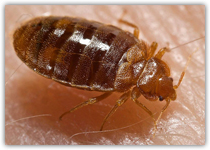 It is a usual notion that pests appear in areas with poor sanitation. But this is not the case with bed bugs, they can make their home anywhere they like. The only way to prevent them is to keep things less cluttered.
It is a usual notion that pests appear in areas with poor sanitation. But this is not the case with bed bugs, they can make their home anywhere they like. The only way to prevent them is to keep things less cluttered.
Bedbugs leave their areas at night time to feed on humans. They prefer to feed on humans but don't mind feeding on birds or family pets. The time duration of the blood meal is between three to ten minutes. The disadvantage of the host is that they don't feel any sensation but the bite can cause a severe itch.
Description:
The adult bed bug is 3/16 inch long, oval, flat, and rusty-red or mahogany in color. The bed bug is flat and thin when unfed but becomes more elongate, plump, and red when it is full of blood. Four-segmented antennae are attached to the head between the prominent compound eyes. The three-segmented beak, or proboscis, is located beneath the head and passes back between the front legs. The bed bug cannot fly as its wings are reduced to short wing pads.
Biology:
As the female bed bug lays her eggs (i.e., one to five per day and 200-500 within her lifetime); she uses a clear substance to attach them in cracks and on rough surfaces. Under ideal conditions, eggs hatch in about seven days and the nymphs molt five times, taking a blood meal between each molt. Development time from egg to adult is 21 days. The adult can live for almost one year.
Habits:
The bed bug hides in cracks and crevices during the day, preferring to rest on wood and paper surfaces instead of stone and plaster. It leaves these harborage areas at night to feed on its host, which include humans, birds, hogs, and family pets. The blood meal requires three to ten minutes and usually goes unnoticed by the victim. After feeding, the bite site may become inflamed and itch severely in sensitive people. Although the bed bug has been associated with over 25 diseases, transmission has not been conclusively proven. Over time, the harborage areas become filled with the molted skins, feces, and old egg shells of the resident bed bugs. These areas have a characteristic "stick bug" smell caused by secretion emitted by the bed bug.
Examples of bed bug bites:
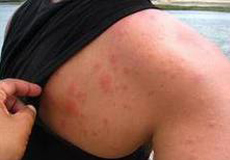
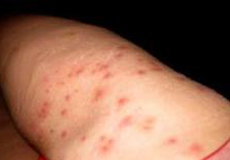
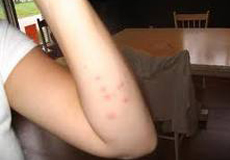
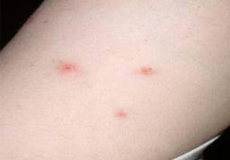
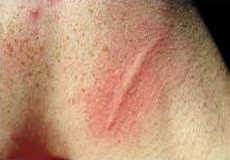
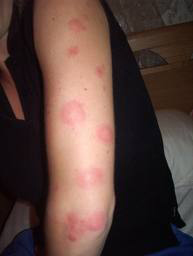
Roaches/Pests Control
Request Free Consultation
"The ants in my garden had really become a nuisance for me. When one of my friends told me about NYGreenEco, I called them to have a look on the garden and offer a solution. They cooked up a customized solution to help me get rid of the miscreants. The way they work is really amazing!"

